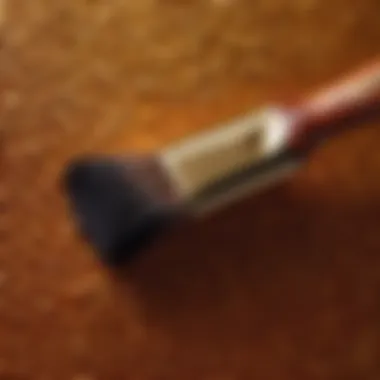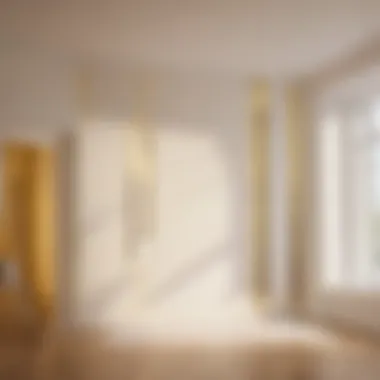Mastering the Art of Painting Walls and Trim: Your Complete Guide to Perfecting Your Space


Materials:
- Interior paint (2 gallons for walls, 1 gallon for trim)
- Primer (1 gallon)
- Painter's tape
- Drop cloths
- Paint trays
- Paintbrushes (angled and straight)
- Paint roller and covers
- Sandpaper (medium grit)
- Caulk and caulking gun
- Putty knife
- Ladder
- Painter's pole
DIY Steps:
- Begin by preparing the walls and trim surface by cleaning and sanding any rough areas.
- Apply painter's tape to protect trim and adjacent surfaces.
- Prime the surfaces to ensure better adhesion and coverage of the paint.
- Start painting the trim first, using a brush or roller depending on the area.
- Once the trim is dry, move on to painting the walls with a roller for larger surfaces.
- Use a trim brush to cut in along edges and corners for a clean finish.
- Apply a second coat if needed for full coverage.
Technical Aspects:
- Recommended tools: Paint sprayer for larger areas, quality brushes and rollers
- Timing specifics: Allow primer to dry for at least 4 hours before applying paint
- Critical techniques: Feathering edges for seamless blending of colors
DIY Project Process:


- Start by painting trim first to avoid splatter on walls.
- Maintain a wet edge while painting to prevent visible lines.
- Check for drips and smoothen them out immediately.
- If encountering paint drips, gently sand them after drying before applying another coat.
- For clean lines, remove painter's tape at a slight angle before the paint fully dries.
Troubleshooting Tips:


- If paint is peeling, ensure the surface was properly cleaned and primed.
- Uneven coverage may happen with thin paint application, apply an additional coat.
- Blotchy finish indicates inconsistent application, smooth out with a final coat.
Enjoying the Result: After completing the painting process, step back and admire the transformation of your space. Bask in the accomplishment of mastering the art of painting walls and trim, knowing you've elevated your home with a touch of personalized beauty.
Introduction


Mastering the art of painting walls and trim is a crucial skill that can significantly enhance the aesthetics of your living spaces while adding value to your property. Properly painting walls and trim goes beyond just adding color; it is about attention to detail, precision, and achieving a flawless finish that elevates the overall look and feel of a room. By delving into this comprehensive guide, you will learn the intricacies of each step involved in the painting process, enabling you to transform your home with confidence and expertise.
Understanding the Importance of Properly Painting Walls and Trim
Enhancing Aesthetics
Enhancing aesthetics through proper painting techniques involves more than just choosing the right color. It encompasses creating a cohesive look that complements the style and ambiance of your space. By selecting the appropriate finishes, textures, and color schemes, you can transform a room into a customized and visually appealing area. The key characteristic of enhancing aesthetics lies in the ability to evoke emotions and set the tone for the room. This choice is popular because it allows for personal expression and creativity, making each space unique. However, a potential disadvantage could be the need for meticulous planning and execution to ensure harmony in the overall design.
Protecting Surfaces
Protecting surfaces is essential when painting walls and trim to maintain the integrity of your property. A key aspect of this process is safeguarding against paint splatters, drips, and stains that can damage adjacent surfaces. By utilizing painter's tape effectively, you create clean, sharp lines that delineate areas to be painted, reducing the risk of accidental spills. The main benefit of protecting surfaces is the preservation of surrounding structures, such as baseboards, floors, and ceilings, ensuring a professional and polished look. One disadvantage could be the time-consuming nature of this step, but the long-term protection it provides outweighs any minor inconvenience.
Increasing Property Value
Properly painting walls and trim can significantly increase the value of your property. A freshly painted interior not only enhances the visual appeal but also gives the impression of a well-maintained and cared-for home. This attention to detail signals to potential buyers that the property has been looked after, potentially leading to a higher resale value. The main characteristic of increasing property value through painting lies in the ability to create a positive first impression that can influence a buyer's perception of the entire property. This choice is popular among homeowners looking to maximize their investment and expedite the selling process. However, one downside could be the initial cost involved in painting, but the potential return on investment makes it a worthy endeavor.
Essential Tools and Materials
Paint Brushes
Paint brushes are indispensable tools when it comes to painting walls and trim, allowing for precision and control over details. The key characteristic of paint brushes lies in their ability to deliver smooth and even coats of paint, especially in areas where rollers may struggle to reach. Using high-quality paint brushes ensures a professional finish andcontinues with detailed descriptions for Rollers, Painter's Tape, and Drop Cloths.
Preparation Stage
In the realm of mastering the art of painting walls and trim, the preparation stage stands as a critical foundation for achieving a flawless finish. This pivotal phase sets the tone for the entire painting process, emphasizing the significance of meticulous planning and attention to detail. By focusing on the preparation stage, individuals can ensure that their surfaces are primed and ready for optimal paint adhesion, enhancing the longevity and aesthetics of the final outcome.
The preparation stage encompasses a comprehensive approach to readying the walls and trim for the transformative art of painting. By delving deep into this initial phase, individuals can lay the groundwork for a successful painting project that elevates the overall appeal and integrity of their living spaces.
Surface Preparation
Cleaning the Walls and Trim
Cleaning the walls and trim serves as a fundamental step in the surface preparation process, ensuring that the painting surface is free from dirt, dust, and other contaminants. By meticulously cleaning the surfaces, individuals pave the way for smooth paint application and improved adhesion, ultimately contributing to a seamless finish.
One key characteristic of cleaning the walls and trim is its ability to create a clean canvas for the paint, allowing for better color accuracy and uniformity. This meticulous step is a popular choice in this article due to its foundational importance in achieving professional-quality results. While the process may require time and effort, the benefits of starting with a clean surface far outweigh any disadvantages, as it sets the stage for a visually appealing and long-lasting paint job.
Sanding Imperfections
Sanding imperfections plays a crucial role in surface preparation by smoothing out uneven areas, rough patches, and old paint residue. This process is essential for creating a uniform and flawless surface that promotes optimal paint adhesion and coverage. By addressing imperfections through sanding, individuals can achieve a professional finish that enhances the overall aesthetic appeal of their walls and trim.
The key characteristic of sanding imperfections lies in its ability to create a level surface that ensures even paint distribution and adherence. This method is a popular choice in this article because of its effectiveness in prepping the surface for paint, resulting in a seamless and refined finish. While the process may entail some manual labor, the advantages of sanding imperfections translate to a final result that is both visually appealing and durable.
Filling Holes and Cracks
Filling holes and cracks is a pivotal step in surface preparation, addressing any damages or imperfections on the walls and trim. By filling these gaps with suitable materials, individuals can achieve a smooth and pristine surface that is ready for painting. This process not only enhances the appearance of the walls and trim but also ensures a solid foundation for the paint to adhere to, preventing future issues.
The key characteristic of filling holes and cracks is its ability to restore the integrity of the surface, masking any blemishes and creating a seamless finish. This approach is a beneficial choice in this article for its capacity to rectify surface imperfections and promote a flawless paint application. While there may be minor disadvantages such as additional time and materials required, the advantages of filling holes and cracks align with the goal of creating a professional-looking paint job.
Protecting Adjacent Surfaces
In the realm of painting walls and trim, protecting adjacent surfaces is a crucial step to prevent accidental paint spills, splatters, or damages. By employing strategic measures to safeguard surrounding areas, individuals can streamline the painting process and maintain a clean workspace. This meticulous care not only protects furniture, flooring, and fixtures but also contributes to a hassle-free painting experience that yields impeccable results.
Using Painter's Tape
The use of painter's tape is a key tactic in protecting adjacent surfaces, offering a straightforward and effective way to delineate paint boundaries and achieve clean, sharp lines. By carefully applying painter's tape along edges and trim, individuals can create a barrier that prevents paint from seeping onto unwanted areas, resulting in a professional and polished finish.
The key characteristic of using painter's tape is its precision in defining paint boundaries, enabling individuals to maintain a neat and tidy painting process. This method is a popular choice in this article for its ability to ensure crisp paint lines without the need for meticulous hand masking. While there may be slight drawbacks associated with tape adhesion and removal, the benefits of using painter's tape for surface protection far outweigh any inconveniences, making it an essential tool for achieving a high-quality paint job.
Laying Drop Cloths
Laying drop cloths is an essential practice in protecting floors, furniture, and other surfaces from paint drips, spills, and splatters. By strategically placing drop cloths in work areas, individuals can minimize cleanup and prevent damage to surrounding elements, fostering a more organized and efficient painting process. This preventive measure not only safeguards property but also instills a sense of professionalism and care in executing the painting project.
The key characteristic of laying drop cloths is its ability to create a barrier that absorbs paint and prevents it from reaching delicate surfaces, minimizing potential mess and damage. This technique is a beneficial choice in this article for its practicality in maintaining a tidy workspace and facilitating post-painting cleanup. While there may be considerations regarding positioning and securing drop cloths effectively, the advantages of using this protective measure far outweigh any challenges, leading to a smoother and more controlled painting experience.
Application Process
In the realm of painting walls and trim, the application process plays a pivotal role in achieving a flawless and professional finish. It is at this stage that the transformative power of color takes shape, breathing life into the surfaces of a room. The proper execution of the application process ensures not only aesthetically pleasing results but also lasting durability.
Priming the Walls and Trim
Types of Primers
When delving into the priming stage of painting walls and trim, the choice of primer holds significant importance. Different types of primers cater to specific needs, such as covering stains, promoting adhesion, or blocking odors. For instance, an oil-based primer is preferred for covering stubborn stains, while a multi-surface primer provides versatility across various materials. Understanding the unique characteristics of each primer type enables optimal surface preparation, enhancing the longevity and vibrancy of the paint job.
Application Techniques
The application techniques employed during the priming stage are essential for laying a solid foundation for the paint to adhere to. Whether using a brush, roller, or sprayer, the key lies in achieving uniform coverage while minimizing drips and streaks. Proper priming sets the stage for a smooth and seamless painting process, ensuring a professional-looking outcome that enhances both the aesthetics and longevity of the paint.
Painting the Walls and Trim
Choosing the Right Paint
Selecting the appropriate paint for walls and trim is critical for achieving the desired look and performance. Factors such as finish type, durability, and sheen level play a role in determining the ideal paint choice. For walls, a washable and durable paint is recommended to withstand everyday wear and tear, while trim paint should offer superior adhesion and a flawless finish. By carefully considering these aspects, one can ensure a successful painting project that meets both aesthetic and functional requirements.
Applying Paint with Brushes and Rollers
The method of applying paint with brushes and rollers influences the texture and finish of the painted surfaces. Brushes are ideal for precision work on trim and edges, while rollers are efficient for larger wall areas. Understanding how to use each tool effectively, such as feathering edges and maintaining a wet edge, is key to achieving a seamless and professional-looking result. Skillful application techniques contribute to a visually appealing finish that showcases attention to detail and craftsmanship.
Achieving Smooth and Even Coverage
Achieving smooth and even coverage is the hallmark of a well-executed paint job. Consistent brush strokes or roller passes help distribute the paint evenly, minimizing visible seams or patches. Strategies such as working in small sections, maintaining a consistent pressure, and blending wet edges contribute to a cohesive and uniform finish. By focusing on achieving smooth and even coverage, one can elevate the overall aesthetics of the painted walls and trim, creating a polished and harmonious living space.
Finishing Touches
Finishing touches play a crucial role in the overall painting process, ensuring that the walls and trim are perfected to achieve a flawless finish that enhances the aesthetic appeal of the entire room. These final steps not only contribute to the visual appeal but also serve to protect the surfaces and prolong the longevity of the paint job. When executed meticulously, the finishing touches can elevate the entire painting project, leaving a lasting impression on anyone who enters the space. It is essential to pay attention to every detail during this stage to achieve a professional and polished look. By focusing on trim work and cleaning up, you can transform your living space into a masterpiece that exudes sophistication and elegance.
Trim Work
Trim work involves the meticulous detailing around the edges and corners of walls, adding a refined and polished look to the overall painting project. Cutting-in techniques play a vital role in achieving sharp and precise lines between the walls and trim, creating a seamless transition that enhances the visual impact of the room. This technique requires a steady hand and attention to detail to ensure a clean and professional finish. Detailing corners and edges further enhances the aesthetic appeal, emphasizing the architectural features of the room and adding depth and dimension to the space. Proper execution of trim work requires patience and precision but ultimately contributes to the overall beauty and sophistication of the painted surfaces.
Cutting-In Techniques
Cutting-in techniques involve hand-painting the edges and corners of walls and trim to achieve clean lines and seamless transitions between different surfaces. This method allows for precise detailing without the need for additional tape, ensuring a professional finish that elevates the overall look of the room. The key characteristic of cutting-in techniques is its ability to achieve sharp lines and intricate details that enhance the visual appeal of the painted surfaces. While this technique may be time-consuming, its precision and attention to detail make it a popular choice for achieving a high-quality finish in painting projects.
Detailing Corners and Edges
Detailing corners and edges involves highlighting the architectural features of the room by meticulously painting the intricate junctions where walls meet trim. This attention to detail adds depth and definition to the space, emphasizing the craftsmanship of the painting job. The key characteristic of detailing corners and edges is its ability to enhance the overall aesthetic of the room, creating a clean and visually appealing finish. While this process may require additional time and effort, the unique feature of detailing corners and edges lies in its ability to elevate the sophistication and elegance of the painted surfaces, making it a valuable addition to any painting project.
Cleaning Up
Proper disposal of materials and cleaning tools are essential aspects of the finishing touches, ensuring that the painting project is completed with care and responsibility. Disposing of materials properly not only helps maintain a clean working environment but also contributes to environmental sustainability by reducing waste. Using the right cleaning tools is crucial for maintaining the longevity of the equipment and ensuring that future painting projects can be carried out with efficiency and precision. By adopting proper disposal practices and regularly cleaning tools, you can prolong the life of your painting equipment and create a safe and organized workspace for future projects.
Proper Disposal of Materials
Proper disposal of materials involves following local guidelines for the safe and environmentally friendly removal of paint cans, brushes, rollers, and other related items. This practice not only prevents pollution and environmental harm but also promotes responsible and sustainable painting habits. The key characteristic of proper disposal of materials is its contribution to reducing waste and minimizing the ecological footprint of painting projects. While this practice may require additional effort, its advantages lie in promoting a clean and sustainable approach to home improvement projects, making it an essential consideration for conscientious homeowners.
Cleaning Tools
Cleaning tools play a vital role in maintaining the efficiency and quality of painting equipment, ensuring that they remain in optimum condition for future use. Properly cleaned tools not only last longer but also contribute to achieving smoother and more precise paint application, leading to professional-looking results. The key characteristic of cleaning tools is their ability to preserve the quality and functionality of brushes, rollers, and other equipment, prolonging their lifespan and performance. While cleaning tools may seem like a mundane task, the unique feature of this practice lies in its impact on the overall success and longevity of painting projects, making it a valuable investment in the maintenance of your painting arsenal.
Troubleshooting Tips
Troubleshooting tips serve as a vital component of this comprehensive guide, ensuring that readers are equipped to handle unforeseen challenges during their painting journey. By focusing on specific elements such as addressing common painting issues, readers can enhance their problem-solving skills and achieve professional results. The inclusion of troubleshooting tips showcases the practical approach of this guide, emphasizing the importance of overcoming obstacles efficiently to maintain seamless progress.
Dealing with Common Painting Issues
Drips and Runs
Drips and runs represent a common challenge faced by painters, often leading to uneven paint application and unsightly drips on walls and trim. Understanding the causes of drips and runs is crucial in preventing their occurrence and maintaining a flawless finish. This section delves into the unique characteristics of drips and runs, highlighting their impact on the overall painting process. By addressing this issue proactively, readers can effectively troubleshoot and rectify any unwanted drips or runs, ensuring a professional-looking outcome.
Bleed-Through
Bleed-through is a phenomenon where the underlying surface discolors the fresh paint, compromising the aesthetic appeal of walls and trim. Recognizing the key characteristics of bleed-through is essential for implementing targeted solutions that mitigate this issue. This section explores the factors contributing to bleed-through and provides practical strategies to combat its effects. By gaining insights into addressing bleed-through effectively, readers can enhance the longevity and visual appeal of their painted surfaces.
Uneven Coverage
Uneven coverage can diminish the overall quality of a paint job, resulting in patchy surfaces that detract from the desired aesthetic. Identifying the root causes of uneven coverage enables painters to implement corrective measures and achieve uniformity in paint application. This segment delves into the specific characteristics of uneven coverage, shedding light on its implications for the final result. By employing techniques to address uneven coverage, readers can elevate the quality of their paintwork and achieve professional-looking outcomes.
Tips for Touch-Ups
Blending Paint
Blending paint seamlessly is essential for achieving cohesive touch-ups that seamlessly integrate with the existing paintwork. Understanding the nuances of blending paint assists individuals in maintaining consistency and harmony across painted surfaces. This section explores the key characteristics of blending paint and its role in achieving flawless touch-ups. By mastering the art of blending paint effectively, readers can achieve seamless repairs and enhance the overall visual continuity of their walls and trim.
Minimizing Brush Marks
Minimizing brush marks is crucial for attaining a smooth and professional finish when executing touch-ups or detailing work. The ability to minimize brush marks contributes to the overall aesthetic appeal and ensures a high-quality outcome. This section delves into the unique features of minimizing brush marks, highlighting their significance in achieving refined paintwork. By implementing strategies to reduce brush marks, readers can elevate the precision of their painting techniques and achieve seamless touch-ups that blend seamlessly with the surrounding surfaces.



